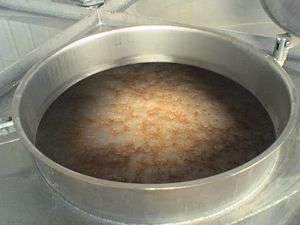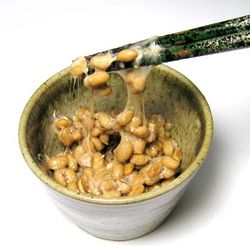Fermentation (food)
Fermentation in food processing typically is the conversion of carbohydrates to alcohols and carbon dioxide or organic acids using yeasts, bacteria, or a combination thereof, under anaerobic conditions. A more restricted definition of fermentation is the chemical conversion of sugars into ethanol. The science of fermentation is known as zymology.
Fermentation usually implies that the action of microorganisms is desirable, and the process is used to produce alcoholic beverages such as wine, beer, and cider. Fermentation is also employed in preservation techniques to create lactic acid in sour foods such as sauerkraut, dry sausages, kimchi and yogurt, or vinegar (acetic acid) for use in pickling foods.
Contents |
History
Since fruits ferment naturally, fermentation precedes human history. Since ancient times, however, humans have been controlling the fermentation process. The earliest evidence of winemaking dates from eight thousand years ago, in Georgia, in the Caucasus area.[1] Seven-thousand-year-old jars containing the remains of wine have been excavated in the Zagros Mountains in Iran, which are now on display at the University of Pennsylvania.[2] There is strong evidence that people were fermenting beverages in Babylon circa 5000 BC,[3] ancient Egypt circa 3150 BC,[4] pre-Hispanic Mexico circa 2000 BC,[3] and Sudan circa 1500 BC.[5] There is also evidence of leavened bread in ancient Egypt circa 1500 BC[6] and of milk fermentation in Babylon circa 3000 BC.
French chemist Louis Pasteur was the first known zymologist, when in 1854 he connected yeast to fermentation. Pasteur originally defined fermentation as "respiration without air". Pasteur performed careful research and concluded;
"I am of the opinion that alcoholic fermentation never occurs without simultaneous organization, development and multiplication of cells.... If asked, in what consists the chemical act whereby the sugar is decomposed ... I am completely ignorant of it."
Contributions to biochemistry
When studying the fermentation of sugar to alcohol by yeast, Louis Pasteur concluded that the fermentation was catalyzed by a vital force, called "ferments," within the yeast cells. The "ferments" were thought to function only within living organisms. "Alcoholic fermentation is an act correlated with the life and organization of the yeast cells, not with the death or putrefaction of the cells,"[7] he wrote.
Nevertheless, it was known that yeast extracts ferment sugar even in the absence of living yeast cells. While studying this process in 1897, Eduard Buchner of Humboldt University of Berlin, Germany, found that sugar was fermented even when there were no living yeast cells in the mixture,[8] by a yeast secretion that he termed zymase.[9] In 1907 he received the Nobel Prize in Chemistry for his research and discovery of "cell-free fermentation."
One year prior, in 1906, ethanol fermentation studies led to the early discovery of NAD+.[10]
Uses
The primary benefit of fermentation is the conversion of sugars and other carbohydrates, e.g., converting juice into wine, grains into beer, carbohydrates into carbon dioxide to leaven bread, and sugars in vegetables into preservative organic acids.
Food fermentation has been said to serve five main purposes:[11]
- Enrichment of the diet through development of a diversity of flavors, aromas, and textures in food substrates
- Preservation of substantial amounts of food through lactic acid, alcohol, acetic acid and alkaline fermentations
- Biological enrichment of food substrates with protein, essential amino acids, essential fatty acids, and vitamins
- Elimination of antinutrients
- A decrease in cooking times and fuel requirements
Some fermentation products (e.g., fusel alcohol) are deleterious.
Fermented foods by region
- Worldwide: alcohol, wine, vinegar, olives, yogurt, bread, cheese
- Asia
- East and Southeast Asia: amazake, asinan, atsara, bai-ming, belacan, burong mangga, com ruou, dalok, doenjang (된장), douchi, jeruk, lambanog, kimchi (김치), kombucha, leppet-so, narezushi, miang, miso, nata de coco, nata de pina, natto, naw-mai-dong, pak-siam-dong, paw-tsaynob (雪裡蕻), prahok, ruou nep, sake, seokbakji, soy sauce, stinky tofu, szechwan cabbage (四川泡菜), tai-tan tsoi, chiraki, tape, tempeh, totkal kimchi, yen tsai (醃菜), zha cai (榨菜)
- Central Asia: kumis (mare milk), kefir, shubat (camel milk)
- India: achar, appam, dosa, dhokla, dahi (yogurt), idli, mixed pickle
- Nepal: achar, dahi (yogurt), gundruk, jaand (rice beer), sinki, tongba
- Bangladesh: achar (various pickles), doi (yogurt), shick kabab (grilled fermented meat), Tari (fermented palm juice), panta vat (fermented rice), Ponir (cheese), lassi (drink), borhani (drink)
- Africa: fermented millet porridge, garri, hibiscus seed, hot pepper sauce, injera, lamoun makbouss, laxoox, mauoloh, msir, mslalla, oilseed, ogi, ogili, ogiri
- Americas: chicha, elderberry wine, kombucha, pickling (pickled vegetables), sauerkraut, lupin seed, oilseed, chocolate, vanilla, tabasco, tibicos
- Middle East: kushuk, lamoun makbouss, mekhalel, torshi, boza
- Europe: rakfisk, sauerkraut, ogórek kiszony, surströmming, mead, elderberry wine, salami, prosciutto, cultured milk products such as quark, kefir, filmjölk, crème fraîche, smetana, skyr.
- Oceania: poi, kaanga pirau (rotten corn), sago
Fermented foods by type
Bean-based
Cheonggukjang (청국장), doenjang (된장), miso (味噌 (みそ)), natto (納豆 (なっとう)), soy sauce, stinky tofu (臭豆腐), tempeh
Grain-based

Amazake, beer, bread, choujiu, gamju (감주), injera, makgeolli, murri, ogi, sake, sikhye, sourdough, rice wine, malt whisky, grain whisky, vodka, batter
Vegetable-based
Kimchi (김치), mixed pickle, sauerkraut
Fruit-based
Honey-based
Dairy-based
Cheese, kefir, kumis (mare milk), shubat (camel milk), cultured milk products such as quark, filmjölk, crème fraîche, smetana, skyr, yogurt
Fish-based
Bagoong, faseekh (ﻓﺴﻳﺦ), fish sauce, Garum, Hákarl, jeotgal (젓갈), rakfisk, shrimp paste, surströmming
Meat-based
Jamón ibérico, Chorizo, Salami, pepperoni
Risks of consuming fermented foods
Food that is improperly fermented has a notable risk of exposing the eater to botulism.
Alaska has witnessed a steady increase of cases of botulism since 1985. Despite its small population, it has more cases of botulism than any other state in the United States of America.[12] This is caused by the traditional Eskimo practice of allowing animal products such as whole fish, fish heads, walrus, sea lion and whale flippers, beaver tails, seal oil, birds, etc., to ferment for an extended period of time before being consumed. The risk is exacerbated when a plastic container is used for this purpose instead of the old-fashioned method, a grass-lined hole, as the botulinum bacteria thrive in the anaerobic conditions created by the air-tight enclosure in plastic.[12]
See also
- Bletting
- Brewing
- Corn smut
- Fermentation (biochemistry)
- Fermentation (wine)
- Fermentation lock
- Food microbiology
- Industrial fermentation
- Industrial microbiology
- Winemaking
- Yeast
- Category:Fermented beverages
References
- ↑ "8,000-year-old wine unearthed in Georgia". The Independent. 2003-12-28. http://www.stonepages.com/news/archives/000498.html. Retrieved 2007-01-28.
- ↑ "Now on display . . . world's oldest known wine jar". http://www.museum.upenn.edu/new/research/Exp_Rese_Disc/NearEast/wine.shtml. Retrieved 2007-01-28.
- ↑ 3.0 3.1 "Fermented fruits and vegetables. A global perspective". FAO Agricultural Services Bulletins - 134. http://www.fao.org/docrep/x0560e/x0560e05.htm. Retrieved 2007-01-28.
- ↑ Cavalieri, D; McGovern PE, Hartl DL, Mortimer R, Polsinelli M. (2003). "Evidence for S. cerevisiae fermentation in ancient wine.". Journal of Molecular Evolution 57 Suppl 1: S226–32. doi:10.1007/s00239-003-0031-2. 15008419. http://www.oeb.harvard.edu/hartl/lab/publications/pdfs/Cavalieri-03-JME.pdf. Retrieved 2007-01-28.
- ↑ Dirar, H., (1993), The Indigenous Fermented Foods of the Sudan: A Study in African Food and Nutrition, CAB International, UK
- ↑ Sugihara, T.F., (1985), Microbiology of Breadmaking, in "."Microbiology of Fermented Foods", edited by Wood, B.J.B., Elsevier Applied Science Publishers, UK
- ↑ Dubos J. (1951). "Louis Pasteur: Free Lance of Science, Gollancz. Quoted in Manchester K. L. (1995) Louis Pasteur (1822–1895)--chance and the prepared mind.". Trends Biotechnol 13 (12): 511–515. PMID 8595136.
- ↑ Nobel Laureate Biography of Eduard Buchner at http://nobelprize.org
- ↑ "The Nobel Prize in Chemistry 1929". http://nobelprize.org/nobel_prizes/chemistry/laureates/1929/press.html. Retrieved 2007-01-28.
- ↑ Harden, A; Young, WJ (October 1906). "The Alcoholic Ferment of Yeast-Juice". Proceedings of the Royal Society of London 78 (526): pp. 369–375.
- ↑ Steinkraus, K. H., Ed. (1995). Handbook of Indigenous Fermented Foods. New York, Marcel Dekker, Inc.
- ↑ 12.0 12.1 "Why does Alaska have more botulism?". http://www.phppo.cdc.gov/phtn/botulism/alaska/alaska.asp. Retrieved 2007-01-28.
- The 1811 Household Cyclopedia
External links
- Fermentations in world food processing (1st part, PDF file)
- Fermentations in world food processing (2nd part, PDF file)
- Science aid: Fermentation - Process and uses of fermentation
- Fermented cereals. A global perspective - FAO 1999
|
||||||||||||||||||||||||||||||||||||||||||||
|
|||||

